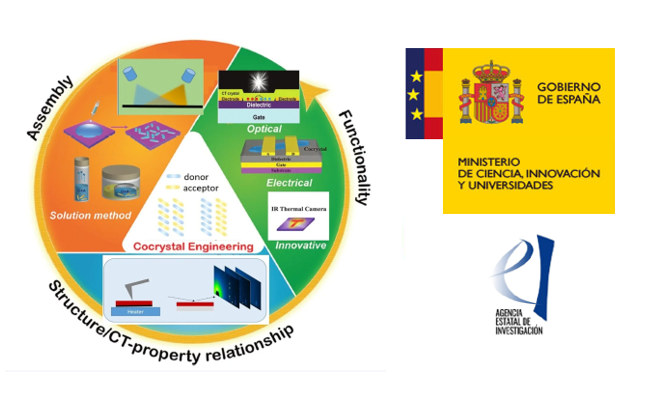
OPINOS: Operando and in-situ multimode characterization of organic semiconductors for a comprehensive design of high performance electronic devices (PID2022-136802NB-I00)
Operando and in-situ multimode characterization of organic semiconductors for a comprehensive design of high performance electronic devices (OPINOS)
The exceptional chemical versatility of pi-conjugated organic materials as organic semiconductors
(OSCs), coupled with their ease in processing and adaptability to any substrate shape, size, and
type, make them excellent candidates for a broad range of (opto)electronic applications addressing
the fields of energy, environment, health, information, communication, robotics, and sensing. And
still, in spite of the great progress over the last few years, organic light emitting diodes (OLED)
are the only organic devices commercialized so far. One of the solid-state devices that has been at
the heart of the quest for commercially viable organic electronics is the organic field-effect
transistor (OFET), not only as electronic component in circuits, but also for the development of low cost
(bio)-chemical sensors. Furthermore, co-crystallization of molecules with electron donor (D) and
acceptor (A) properties to form charge-transfer complexes (CTCs) have emerged as one of the promising
field of research to obtain novel electrical and optical properties, which are far beyond the
performance of single materials, and avoiding complicated and time-consuming organic synthesis
procedures. Selection of suitable D and A systems enables a large range of tunable structures, i.e.,
offering a library of high-performance organic semiconductors with a fascinating prospect of
applications. While the parent compounds tend to be unipolar semiconductors, CTCs can vary in band
gap from insulators to metals, and can even be superconductors. In relation to OFETs, organic
CTCs provide a new way to realize OSC semiconductors with ambipolar behavior and air-stable n-type
OFETs and near-infrared photo-response. However, several challenges remain before OFETs-related
applications can become a widespread commercial reality. Despite its accepted importance by the
organic electronics community, optimizing the performance of OSCs through thin film engineering is
complicated by the fact that the relationship between microstructure, morphology, and transport
properties is still far from being well established. Besides, polymorphism can add a major hurdle to
overcome for a promising functional property to be exploited.
